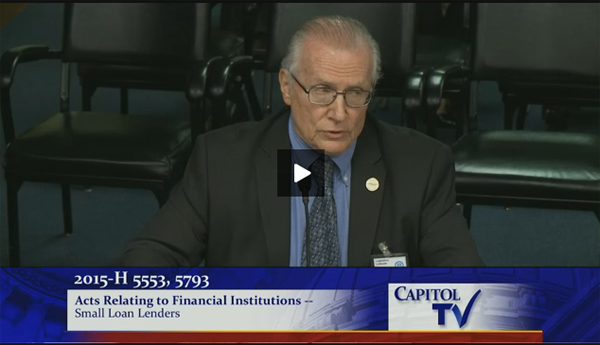AARP Hearing Center

AARPRI joined a group of the state's public interest advocates to testify once again on a bill to reign in Rhode Island payday lenders. These out-of-state lenders increasingly target recipients of Social Security and other government benefits, including disability and veteran's benefits. Below is the May 20th written testimony submitted by AARP@TheStateHouse volunteer Gerry McAcoy as well as video of his oral testimony.
| Testimony, HB 5553 AN ACT RELATING TO FINANCIAL INSTITUTIONS – SMALL LOAN LENDERS House Committee on Finance Wednesday, May 20, 2015 |
Chairman Gallison and Members of the Committee:
My name is Gerald McAvoy, and I am here on behalf of AARP Rhode Island, which represents more than 130,000 members in the State. Thank you for the opportunity to speak today. I would like to share with you AARP’s support for House Bill 5553, An Act Relating to Financial Institutions – Small Loan Lenders, which would protect Rhode Island consumers from high-cost short-term lending, sometimes called payday lending, that traps low income consumers in a cycle of unaffordable debt.
Payday lenders charge outrageous interest rates and impose fees designed to make it inevitable that the borrower will be unable to repay the loan. Payday lenders understand that borrowers often will not be able to both pay their loans and make ends meet until the next payday, meaning borrowers are forced to re-borrow. Payday loans by design are debt traps. The business model depends on keeping borrowers stuck in this long-term high cost debt. More than 60% of payday loan revenue is generated by borrowers with 12 or more loans a year. [i] As industry leaders themselves acknowledged, the payday lending business model depends on keeping borrowers in debt. [ii]
Older people are frequently targeted for these predatory loans. [iii] Though older Americans do not make up a disproportionate share of payday borrowers overall, they make up a significant and growing share. As noted by the Wall Street Journal, “such lenders are increasingly targeting recipients of Social Security and other government benefits, including disability and veteran's benefits.” [iv] A study commissioned by the WSJ shows that payday loan shops cluster near housing for seniors and the disabled. Payday lenders make these high-cost loans available to borrowers whose only source of income is a Social Security or disability check despite efforts by the federal government to limit payday lender access to Social Security benefits.
The harm caused to older people by these lenders is profound. Increasingly, people are nearing their retirement years with high, even unaffordable levels of debt. [v] The consequences of unaffordable debt can be devastating, especially at a time in one’s life when income typically decreases, medical expenses increase, and remaining working years are limited.
The harm payday loans cause is not limited to the borrowers. A recent study evaluated the injury to the U.S. economy in lost spending and in jobs lost as a direct result of payday lending. The Insight Center for Community Economic Development (Insight Center) found “that the payday lending industry had a negative impact of $774 million in 2011, resulting in the estimated loss of more than 14,000 jobs. U.S. households lost an additional $169 million as a result of an increase in Chapter 13 bankruptcies linked to payday lending usage, bringing the total loss to nearly $1 billion.” [vi] This amounts to a loss of “an estimated 24 cents” to the U.S. economy for each dollar in interest paid. Payday lending costs Rhode Island an estimated net loss of over $1.6 million.
It is time to put an end to the outrageous rates allowed with payday lending and the harm it causes to Rhode Island and its citizens.
Thank you again for your time today.
Submitted by
Gerald McAvoy
East Providence
[i] See Uriah King & Leslie Parrish, Ctr. for Responsible Lending , Springing the Debt Trap, 11-12 (2007) (payday lenders and industry observers commenting on the necessity of return customers). Available at http://www.responsiblelending.org/payday-lending/research-analysis/springing-the-debt-trap.pdf.
[ii] Id.
[iii] See Ann McLarty Jackson, Donna V.S. Ortega, Elizabeth Costle, George Gaberlavage, Naomi Karp, Neal Walters, Vivian Vasallo, A Portrait of Older Underbanked and Unbanked Consumers: Findings from a National Survey (September 2010). Available at http://www.aarp.org/money/credit-loans-debt/info-09-2010/D19394.html.
[iv] Ellen Schultz and Theo Francis, “High-Interest Lenders Tap Elderly, Disabled,” Wall Street Journal (2008).
[v] See EBRI Notes, Debt of the Elderly and Near Elderly, 1992–2007, Vol. 30, No. 10. p.9 (October 2009). Available at http://www.ebri.org/pdf/notes pdf/EBRI_Notes_10-Oct09.DebtEldly.pdf.
[vi] Tim Lohrentz, The Net Economic Impact of Payday Lending In the U.S., Insight Center for Community Economic Development (March 2012). Available at http://www.insightcced.org/uploads/assets/Net%20Economic%20Impact%20of%20Payday%20Lending.pdf.
Click here to watch Gerry McAcoy's oral testimony, starting 98:00
































































